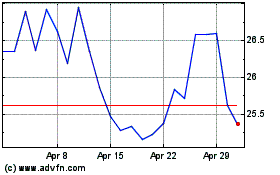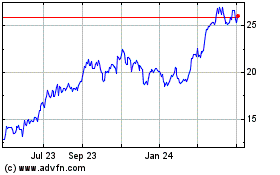U.S. Stocks Open Lower Amid Fresh Trade Tensions With China
November 23 2018 - 10:04AM
Dow Jones News
By David Hodari
U.S. stocks opened lower at the end of a holiday-shortened week,
after China shares fell amid fresh trade fears with the U.S.
The Dow Jones Industrial Average shed 170 points, or 0.7%, to
24294 shortly after the opening bell. The S&P 500 fell 0.5% and
the Nasdaq Composite lost 0.5%.
Trading volumes were expected to be thin during an abridged
postholiday trading session, with volumes in Asia-Pacific markets
also thin due to the Japanese public holiday.
Oil-exposed stocks led indexes lower, with TechnipFMC and
Marathon Oil Corp. down 3.9% and 3.7%, respectively, in premarket
trade.
That came as a fall in oil prices accelerated, with Brent crude
oil plumbing depths not seen since 2017, dropping 2.5% to $61 a
barrel as light trading volumes amplified concerns about rising
supply. West Texas Intermediate futures were down 4.4% at $52.51 a
barrel, their lowest price since late October 2017.
The pan-European Stoxx Europe 600 index gained 0.2% in afternoon
trade. Investors were looking to a scheduled meeting between U.K.
and EU lawmakers over the weekend after both announced Thursday
they had made progress in outlining their future relationship.
Still, the deal faces fierce opposition in both the U.K. and
Europe. The British pound fell 0.4% against the U.S. dollar.
Chinese stocks tumbled, with the Shanghai Composite Index down
2.5% and the tech-heavy Shenzhen A-Share dropping 3.7%, after The
Wall Street Journal reported that the U.S. government had attempted
to persuade foreign allies to avoid telecommunications equipment
from China's Huawei Technologies Co. due to what they see as
cybersecurity risks.
That marked the latest attempt by the Trump administration to
tighten restrictions on Chinese telecom firms. The White House
banned U.S. suppliers from selling components to ZTE, a sector-peer
of Huawei, earlier this year. ZTE shares fell 2% Friday.
" Trump asking allies to stop buying equipment from certain
Chinese technology stocks" could have been behind the decline in
Chinese stocks, said Jeroen Blokland, a portfolio manager at Dutch
asset manager Robeco. Slower news flow and lighter volumes may have
also played a role in the size of the move, he said.
The news of Washington's campaign against Huawei followed the
release of a report by U.S. Trade Representative Robert Lighthizer
earlier in the week in which he accused Beijing of failing to
change economic policies that threaten U.S. industry, such as
cybertheft and espionage.
China's commerce ministry responded on Friday, calling
Washington's accusations groundless, according to media
reports.
However, investors have displayed growing optimism of warming
relations between the world's two largest economies, viewing this
week's developments as a part of the U.S.'s negotiating strategy.
President Trump and China's President Xi Jinping are due to meet at
the Group of 20 summit in Buenos Aires later this month.
"There's clearly a good-cop-bad-cop dynamic here with the new
USTR report aimed at keeping pressure on China," said Isabelle
Mateos y Lago, chief multiasset strategist for BlackRock Inc.
"Markets are already pricing in some kind of good outcome from the
meeting and the baseline not yet fully priced in is that further
escalations in U.S. tariffs are put on hold."
The Chinese yuan was down 0.2% against the dollar Friday, while
the country's banking sector was among those weighing on major
bourses.
Global equities have been volatile in recent weeks, but swings
in Chinese benchmarks have been particularly large, with the
country's assets bruised by Beijing's icy trading relations with
Washington and acting as a bellwether for fears over the health of
global economic growth.
U.S. economic figures have also given investors pause this week.
Falling mortgage applications and rising jobless claims "cast more
doubt on how aggressive the Fed can be in raising rates and how
good the growth outlook is for the U.S. given high rates, a strong
dollar, and fading support from fiscal stimulus at a time of trade
protectionism and weaker global growth," according to James
Knightley, the chief international economist at ING.
In commodities, the price of gold was down 0.4% at $1,223.20 a
troy ounce.
Steven Russolillo
contributed to this article.
Write to David Hodari at David.Hodari@dowjones.com
(END) Dow Jones Newswires
November 23, 2018 09:49 ET (14:49 GMT)
Copyright (c) 2018 Dow Jones & Company, Inc.
TechnipFMC (NYSE:FTI)
Historical Stock Chart
From Mar 2024 to Apr 2024

TechnipFMC (NYSE:FTI)
Historical Stock Chart
From Apr 2023 to Apr 2024
